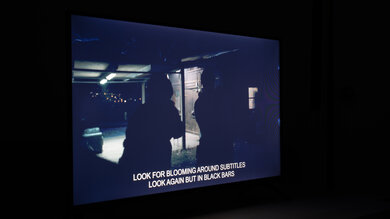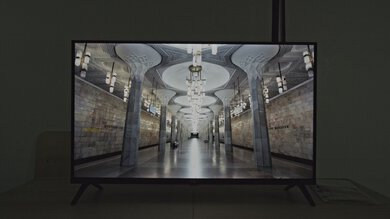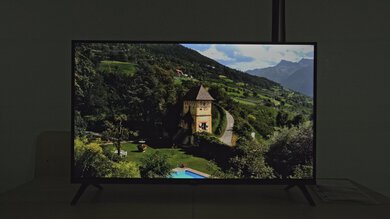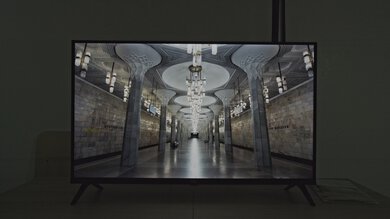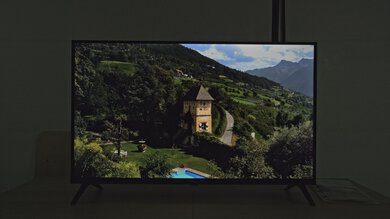The TCL S3/S350G is an entry-level 1080p TV and sits below the 2024 4k entry-level TCL S5/S551G. Even though it's a basic TV, it supports HDR10 alongside Google TV 11. While it doesn't support any advanced gaming features, it does come with a Game Mode. It comes with the same remote as some of TCL's other 2024 models, which has an integrated microphone with Amazon Alexa and Google Assistant support. It also comes with Chromecast built-in, providing easy casting from an Android device. We reviewed the 32-inch model, but it also comes in 40 and 43-inch model sizes.
Our Verdict
The TCL S3 is a disappointing TV overall. It doesn't excel in any usage due to its underwhelming peak brightness in SDR and HDR, inadequate image processing, narrow viewing angle, and low-resolution options. Its worst feature, however, is its awful response time: it's high enough to provide an unpleasant viewing experience when watching sports and also impacts the TV's ability to provide an adequate gaming or PC monitor experience.
Good reflection handling.
Inadequate image processing features.
Narrow viewing angle.
The TCL S3 is a mediocre TV for watching shows. While it has good reflection handling, it is extremely dim in SDR, so it can't handle rooms with any lights. It also has a narrow viewing angle, so it's not a good choice for any wide seating arrangement. It does have a wide array of smart features, including access to a huge selection of streaming apps, so you can easily find your favorite shows. Unfortunately, its image processing is disappointing at best, so it can't clean up low-bitrate or low-resolution shows.
Good reflection handling.
Inadequate image processing features.
Narrow viewing angle.
The TCL S3 is a poor choice for watching sports. While its reflection handling is good, it is simply too dim in SDR to be used in any room with lights or windows. Plus, it has a narrow viewing angle, so it's not a good choice for a wide seating arrangement. Its gray uniformity is inadequate, so there's visible dirty screen effect when watching sports with large areas of bright uniform color, like hockey. Its most glaring issue, however, is its awful response time; there is an extremely noticeable motion blur behind fast-moving players, making for an unpleasant viewing experience.
Good reflection handling.
Inadequate image processing features.
Narrow viewing angle.
Inadequate uniformity with large areas of bright, uniform colors.
The TCL S3 is inadequate for playing games. It has a few redeeming features, such as input lag that is low enough for a pleasant, if unimpressive, gaming experience. It also has good reflection handling, but it doesn't matter much due to the TV's very low SDR brightness; turn off any lights when gaming on this TV. The TV's biggest issue, however, is its awful response time, which introduces a ton of motion blur behind fast-moving objects. This makes it almost unusable for action games. It's also limited to 1080p @ 60Hz on its two HDMI 1.4 ports, with no VRR.
Good reflection handling.
Relatively low input lag.
Inadequate image processing features.
Limited to 1080p on its two HDMI 1.4 ports.
The TCL S3 is a disappointing TV for watching movies. Its contrast is mediocre, but it makes for relatively deep blacks when no highlights are present. Unfortunately, the entire screen is blue whenever bright highlights are there, which is unpleasant when viewed in a pitch-black room. When paired with the TV's disappointing HDR brightness, it results in a rather underwhelming HDR presentation. The TV's pre calibration accuracy in SDR is barely mediocre, so it's not a good TV to watch SDR content if you care about image accuracy.
You shouldn't buy the TCL S3 for HDR gaming. Its HDR peak brightness is extremely low, making for a dull HDR experience overall. It doesn't matter much anyhow, as this TV's response time just isn't good enough for gaming; there's a noticeable motion blur behind any fast-moving elements of the scene. It's even worse in dark titles, as there's an overwhelming amount of black smearing during dark transitions. Finally, it's also limited to 1080p @ 60Hz on its two HDMI 1.4 ports, with no VRR.
Relatively low input lag.
Limited to 1080p on its two HDMI 1.4 ports.
Limited color gamut.
The TCL S3 shouldn't be bought to be used as a PC monitor. It caps out at 1080p, resulting in a very low pixel density when used as a monitor. It's also not quite bright enough in SDR to overcome any lights from an office, even with its good reflection handling. It also has a narrow viewing angle, so the sides of the screen are not uniform with the center when you're sitting close to it. Its most glaring weakness, however, is its awful response time, which results in a ton of motion blur behind fast-moving objects, such as a mouse cursor. It's even worse during dark transitions, so moving bright windows on a dark background will result in an inordinate amount of black smearing, making for a very unpleasant user experience.
Good reflection handling.
Relatively low input lag.
Narrow viewing angle.
Limited to 1080p on its two HDMI 1.4 ports.
Inadequate uniformity with large areas of bright, uniform colors.
Check Price
Differences Between Sizes And Variants
We bought and tested the TCL 32S350G, which is also available in 40- and 43-inch sizes. Our model uses the Google TV smart OS, but the TV is also available with Roku TV as well as Fire TV. While all variants share a similar feature set, there are some differences: the Fire TV variant doesn't come with a Game Mode, while the Roku variants have three HDMI ports instead of two and come with Apple HomeKit and Airplay2 support. In Canada, only the Roku and Google TV variants are available.
| Size | Google TV model (US/Canada) | Roku TV model | Fire TV model |
|---|---|---|---|
| 32" | TCL 32S350G/32S350G-CA | TCL 32S350R/32S350R-CA | TCL 32S350F |
| 40" | TCL 40S350G/40S350G-CA | TCL 40S350R/40S350R-CA | TCL 40S350F |
| 43" | TCL 43S350G/43S350G-CA | TCL 43S350R/43S350R-CA | - |
Our unit was manufactured in February 2024, as shown on the label.
Popular TV Comparisons
You shouldn't buy the TCL 32S350G. While it's a very cheap television, its performance leaves a lot to be desired. It is dim in SDR and HDR, has inadequate image processing, and is limited to 1080p on its two HDMI 1.4 ports. Worse of all, however, is its awful response time, which makes the TV almost unusable for sports, gaming, or use as a PC monitor. You really should consider the similarly priced but much better Hisense A6N and Roku Select Series, as they'll both offer a vastly better experience overall.
See our recommendations for the best budget TVs, the best TVs under $300, and the best smart TVs.
The Roku Select Series is much better than the TCL S350G. The TCL does one thing better than the Roku: upscaling, and not by much. Otherwise, the Roku is the brighter TV in HDR and SDR, with slightly better contrast, offering a more impactful viewing experience in all content. It's also much better for gamers due to its vastly faster response time and up to 4k @ 60Hz resolution support; the TCL is limited to 1080p @ 60Hz on its two HDMI 1.4 ports.
The Hisense A6N is better than the TCL S350G. While the TCL has the better contrast of the two, the Hisense is brighter in HDR and SDR, with a wider color gamut, delivering a more impactful viewing experience overall. It's also the more accurate of the two TVs. The Hisense is vastly better for gamers due to its far quicker response time. Finally, it offers a wider range of resolutions to users, as the TCL is limited to a maximum of 1080p @ 60Hz.
The Samsung DU6900 is better than the TCL S350G. While the TCL has the better contrast, the Samsung is brighter in HDR and SDR, with a wider color gamut, offering a more impactful viewing experience with all content. The TCL is the more accurate of the two TVs in SDR out of the box, but inversely, the Samsung is more accurate in HDR content. The Samsung is also the better option for gamers due to its wider resolution range, barebones VRR feature, and faster response time. The TCL, for its part, is limited to 1080p, has no VRR, and has a truly awful response time.
Test Results

The back of the TV is very plain and looks cheap. The inputs are housed in a larger section of the back, near the center of the TV. There's no cable management.
This TV doesn't have a local dimming feature, so it can't adjust the backlight of individual zones to brighten up highlights without impacting the rest of the image. That means that there are no distracting flickers or brightness changes as bright highlights move across the screen.
Unfortunately, the peak brightness in HDR is bad. Specular highlights are dull and flat, and bright areas of the scene don't stand out.
The brightness in Game Mode is nearly identical to the brightness in 'Movie,' so bright highlights in games still don't stand out at all.
The PQ EOTF tracking on this TV is excellent. Most HDR content is displayed close to the brightness level intended by the content creator. Near-blacks are raised, so some shadow details appear washed out, mainly due to the lack of a local dimming feature. It's also severely limited by its extremely low peak brightness, so bright scenes are too dim. The TV does roll-off when it reaches its peak brightness to try and preserve some detail in bright specular highlights.
The peak brightness of this TV in SDR is bad. It's not bright enough to handle even moderate amounts of glare, so it's not a good choice for a room with any lights or windows.
The TCL S3's color gamut is sub-par. It can't fully display the commonly used DCI-P3 color space, as most colors are undersaturated, with frequent color accuracy errors. It's even worse in the wider Rec. 2020 color space, as here colors are inaccurate and undersaturated. There are also important color mapping issues throughout, more so in saturated greens and cyans.
This TV's color volume is poor. It's limited by its low peak brightness and narrow color gamut, so bright colors don't stand out. It also struggles to display dim saturated colors due to its mediocre contrast.
Unfortunately, the overall accuracy of this TV in SDR before calibration is mediocre. The white balance is noticeably off, as blues are underrepresented in all shades of gray, even more so in brighter grays, making the TV's color temperature too warm overall. When it comes to color accuracy, most saturated colors are noticeably off, and all cyans strongly deviate from what they should be. The gamma is close to our 2.2 target, but all scenes are too dark.
This TV looks much better after calibration, although colors can't be fully calibrated. This means that while most issues regarding white balance are solved, there are still some noticeable color accuracy issues, especially in bright, saturated colors.
See our full calibration settings here.
The TV's gray uniformity is disappointing. The edges of the screen are noticeably darker, and there's noticeable dirty screen effect, leaving dark spots in the upper and lower regions of the image. There are also noticeable uniformity issues on very dark content, with the sides of the screen being noticeably brighter than the center.
The TV has good reflection handling overall. Its semi-gloss screen does an especially good job of reducing the intensity of indirect reflections. However, direct reflections from light sources directly facing the screen are more distracting.
In HDR, gradients aren't displayed well on this TV. There's noticeable banding in almost all colors except for bright grays, reds, and blues. The banding is especially noticeable in darker shades of gray.
The TV uses a BGR (Blue-Green-Red) subpixel layout instead of the traditional RGB layout, and in this case, it's rotated 90 degrees on its side. It results in obvious color fringing when looking at the TV from a close distance. This doesn't cause any issues for video or gaming content, but it can be a problem for PC monitor use as it impacts text clarity.
The TV doesn't use quantum dots, nor does it use a KSF phosphor coating to produce its colors, as confirmed by the TV's spectral power distribution (SPD). Color purity isn't very good, as there's little separation between each color.
The TCL S3's response time is downright awful. There's extremely noticeable motion blur in almost all transitions, which is excellent for watching movies but makes the TV a terrible choice for gaming or sports. Dark transitions are even worse, resulting in excessive black smearing in shadow details.
This TV uses pulse width modulation (PWM) to dim its backlight. It flickers at 150Hz, which is low enough to be noticeable by users who are sensitive to it, especially since it doesn't flicker in time with the TV's refresh rate. Unfortunately, there's flicker in every picture mode, but the TV is flicker-free when the brightness is set to 29 or above.
This TV doesn't have an optional backlight strobing feature, commonly known as black frame insertion (BFI), to help reduce persistence blur.
This TV doesn't have a motion interpolation feature.
Thanks to its extremely slow response time, there's no noticeable stutter when watching movies.
The TV doesn't remove 24p judder from any source.
All sizes of this TV are limited to a 60Hz refresh rate and don't support VRR.
This TV's input lag in Game Mode is low enough to provide a pleasant gaming experience, but it is still significantly higher than that of most other TVs.
The TCL 32S350G only supports 480p, 720p, and 1080p resolutions, all at 60Hz. When set to the 'PC' Picture Mode, it displays chroma 4:4:4 at 1080p properly.
Since this TV is limited to a 60Hz refresh rate, it can't take full advantage of the Xbox Series S|X. It also doesn't support Auto Low Latency Mode, so it doesn't automatically switch to Game Mode when it detects a console.
While the TV does support HDR, the Xbox consoles only support HDR when running at 4k. Thus, this TV can't do HDR on Xbox Series S|X.
This TV is limited to HDMI 1.4 bandwidth on its two HDMI ports.
The TCL 32S350G only supports ARC, but it can passthrough Dolby Digital Plus 7.1, alongside Dolby Digital 5.1. It doesn't support Dolby Atmos, as it instead downsamples it to 2.0. It also doesn't support any DTS audio formats.
The TV has a poor frequency response. There's no noticeable bass response, as the low-frequency extension (LFE) is incredibly high. Above the LFE, the frequency response is mediocre at low-volume settings, and dialogue can sometimes be hard to make out.
There's some noticeable distortion on this TV at moderate volume levels, but it's satisfactory. However, the amount of distortion above 75% volume is rather extreme, rendering it nearly unusable at high volume settings.
It has a wide selection of apps, so it's easy to find your favorite content. You can also cast content from your phone to the TV or play videos directly from a USB stick. However, it doesn't support HDR playback through USB.
The TV's remote is medium-sized and has a simple layout. It has motion-activated backlighting and buttons for popular streaming services. You can use the built-in microphone to switch inputs, change apps, search within apps, and ask for the weather and time. Unfortunately, you can't change the settings using the voice controls.









